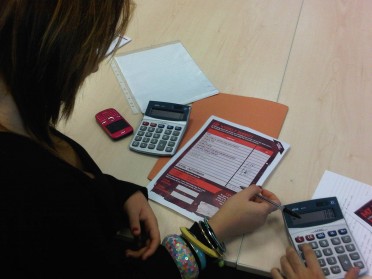 This September, financial education becomes compulsory for 11-16 year olds in English secondary schools in Citizenship and Maths via the new National Curriculum.
This September, financial education becomes compulsory for 11-16 year olds in English secondary schools in Citizenship and Maths via the new National Curriculum.
In the run-up we will be exploring what this means for young people and how we can help teachers implement effective, impactful and yes, fun (!), financial literacy lessons into their classrooms.
Here, we have asked 21-year-old Ruben Vega-Poblete, a recent Mathematics graduate from Bristol University, for his take on the opportunities and pitfalls presented by this autumn’s changes.
“Soon, our mathematics syllabus will include explicit references to teaching financially relevant ideas as part of the maths curriculum. This is not to be understated, it is very very important.
One of the age-old charges against maths is its perceived lack of relevance to the ‘real world’. In this new context, teachers can use financial education to ground mathematical concepts in the real world and make students more interested in the subject, while at the same time maths can give students a deeper understanding and appreciation of what goes on underneath the surface of the financial world.
While there is the obvious use of arithmetic that you need whenever you are dealing with numbers, the use of mathematics in financial matters goes much deeper than that. The calculation of interest and inflation, exchange rates and the assessment of risk all require a knowledge of and comfort with mathematical ideas that can be neglected when giving financial education. Not to mention that without a solid mathematical underpinning you run the risk of treating finance like a vague and unquantifiable concept. On the other side of the coin (no pun intended), statistics and probability are intrinsically linked to financial models and economics and if they are taught only as abstract concepts, an opportunity is missed to engage students and show the relevance of what they are learning.
 From my recent studies I am very aware of both the potential maths has to engage students and help explain the world around them, and the possibility to simply bore them with esoteric knowledge that has seemingly no relevance to their lives.
From my recent studies I am very aware of both the potential maths has to engage students and help explain the world around them, and the possibility to simply bore them with esoteric knowledge that has seemingly no relevance to their lives.
It is not enough to add token references to finances or present contrived problems vaguely related to economics or enterprise, in essence, to just add a pound sign here and there. Our new maths curriculum has to be supported by the teaching of the real world applications, otherwise the financial context just becomes white noise as students only focus on getting the solution to the problem. A knowledge of percentages does not explain to a student why inflation happens or what interest is. Not to mention that there is a sizable gap in between learning the abstract concepts and being able to apply those ideas in a practical situation. When it comes to financial education, as with most education, there has to be a holistic approach that encompasses both the mathematics and the real world context that makes it relevant.
Even so, it is very tempting to separate the subjects, especially when dealing with lower ability students, who might struggle with the more technical aspects. Considering the general antipathy towards mathematics that seems to be held by students and society alike, there could be a perhaps reasonable fear that too much emphasis of financial education in maths could turn off the students who most need the life lessons financial education teaches.
However, the reality of finance is that it does involve heavy use of maths and we should prepare our students for that. So how does MyBnk deal with this? Thankfully, MyBnk does not avoid the maths that underlies the concepts. While still catering for lower ability students MyBnk teaches both how to deal with finance and enterprise in the abstract, as well as the mathematics that allows for an application of those ideas. It is about getting students comfortable with mathematics in a financial setting. This can be as simple as checking that accumulated spending does not exceed your budget, or it could be calculating interest over several years and comparing that to the rate of inflation to calculate real returns. The point is that the understanding of the concepts is reinforced with an understanding of the process that underlies them. If we want students to be genuinely financially literate we have to give them as many of the tools they need to deal with finances in the real world as possible. This includes both a conceptual understanding of finance and enterprise, and a mathematical underpinning to that understanding.
Without both you cannot give a student a complete financial education”.

